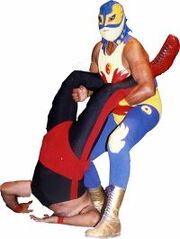The Boston crab is a wrestling hold that typically starts with the opponent laying supine on the mat, with the wrestler standing and facing them. It is a type of spinal lock where the wrestler hooks each of the opponent's legs in one of his arms, and then turns the opponent face-down, stepping over him in the process. The final position has the wrestler in a semi-sitting position and facing away from his opponent, with the opponent's back and legs bent back toward his face. This often sees the attacking wrestler perform double leg takedown while remaining upright with the opponent's legs hook so they can be turned into the Boston crab.
The original name for the maneuver was the backbreaker, before that term became known for its current usage. In modern wrestling, the Boston crab isn't treated as a lethal submission maneuver, even though it was considered a match-ending hold in the past, used by such wrestlers as Rick Martel in the AWA and WWF and Nobuhiko Takada in the original Japanese UWF.
Many different variations are used today, including the Elevated Boston Crab used by Chris Jericho, who calls it the Walls of Jericho. Jericho's original version while in WCW (known then as the Liontamer) involved placing his knee in the small of his opponent's back, thus further wrenching the neck and delivering more pain. Jericho would later alter the move not long after arriving to WWF/E, however, and now the move is a higher version of the Boston Crab.

In Mexican Lucha libre the move is called El Cangrejo.
Variations
- Cross-legged Boston crab
- Grapevined Boston Crab
- Inverted Boston crab
- Rocking horse
- Single leg Boston crab
- Single leg Boston crab with armlock
- Over the shoulder Single leg Boston crab
- Single leg Boston crab with knee
- Rope hung Boston crab
Cross-legged Boston crab
This variation of a normal Boston crab sees the attacking wrestler get a hold of both of the opponent's feet, then crossing both legs over before tucking both legs under its opposite armpit (i.e. left leg under wrestler's right armpit). After completing this, the attacking wrestler turns the opponent face-down, stepping over him/her in the process to secure the hold.
Grapevined Boston Crab
See: Sharpshooter
Inverted Boston crab
Identical to a Boston crab, but with the wrestler facing in the same direction as the opponent. The wrestler squats over the opponent with the opponent's legs positioned under their arms.
Rocking horse
This Boston crab variation sees the wrestler lock the opponent in a standard version of the hold before lifting them off the ground by their arms (while still in the hold), and rocking them back and forth, putting additional pressure on their back.
Single leg Boston crab
Also known as a Half Boston crab or a Half crab, a move that typically starts with the opponent on his back, and the attacking wrestler standing and facing them. The attacking wrestler hooks one of the opponent's legs in one of his/her arms, and then turns the opponent face-down, stepping over him in the process. The final position has the wrestler in a semi-sitting position and facing away from his/her opponent, with the opponent's back and leg bent back toward his/her face, sometimes the attacking wrestler will place their leg so that his/her knee digs into the back of the opponent. A variation with the attacking wrestler kneeling side-ways while having the leg hooked can be performed.
Lance Storm's Canadian Maple Leaf is a variation of this in which he performs a back somersault roll on the mat, catching a charging opponent into the single leg Boston crab.
Single leg Boston crab with armlock
The attacking wrestler approaches a supine opponent and seizes one of their arms before walking around the opponent's head to their other side, thus forcing the opponent to roll onto their stomach. The wrestler then kneels on the back of the opponent, clinching the opponent's arm behind their knee, and applies a single leg Boston crab. This move is used and was popularized by Konnan, who dubbed it the Tequila Sunrise.
Over the shoulder Single leg Boston crab
Single leg Boston crab with knee
Similar to a normal half Boston crab, this move sees the wrestler use a single knee to add additional pressure by pressing it into the opponent's back.
Rope hung Boston crab
This move involves a wrestler hooking each of an opponent's legs in one of his/her arms, and draping the opponent over the top rope, at this point the wrestler would hook the arms of the opponent with his/her legs securing the hold.
As this move involves the use of the ropes, and allows the opponent to touch the ropes (which forces a wrestler to break a submission hold), this hold must usually be broken before the referee completes a five-count
The Tarantula variation of this move (mainly used by Yoshihiro Tajiri) involves the wrestler hooking an opponent's arms around the top rope and legs around the bottom rope, so the move is performed upside down.
